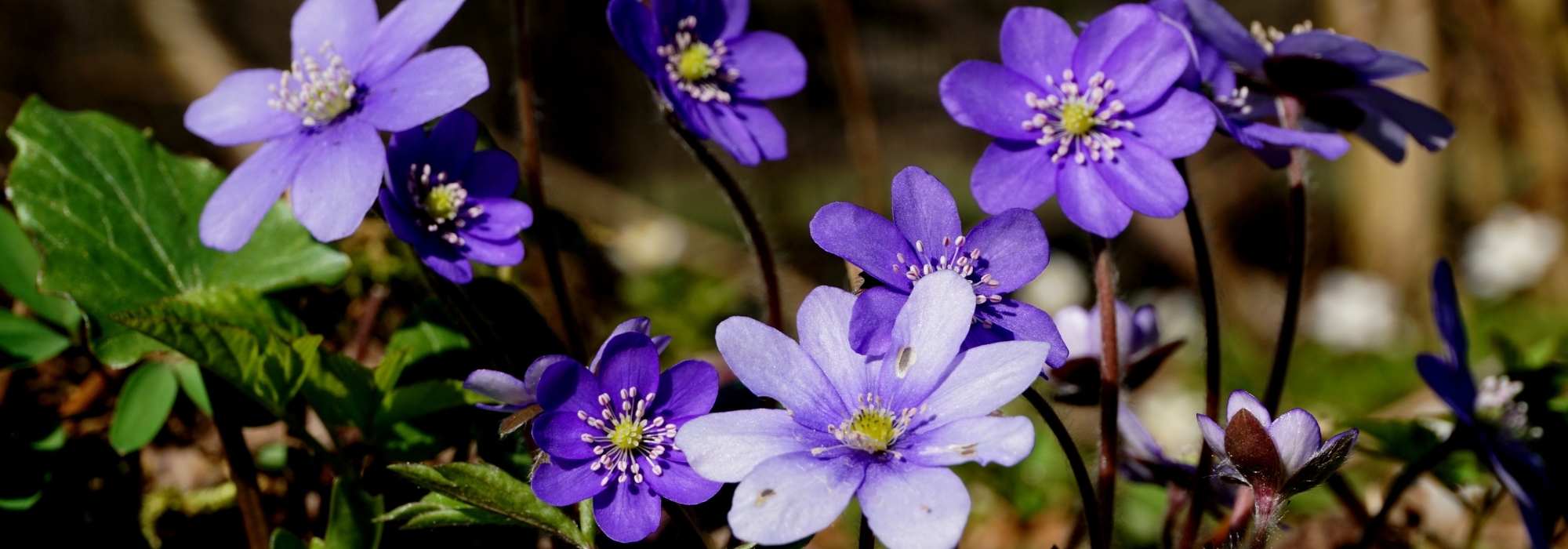
Hepatics: planting and growing
Contents
Hepatics in a nutshell
- These are small perennial plants from the undergrowth that require a spot in partial shade
- They offer a delicate star-shaped flowering in blue, white, or pink from the end of winter
- Their astonishing trilobed foliage persists to varying degrees in winter
- Robust and hardy, they are not demanding in well-drained, cool soil
- They thrive in your borders and rockeries in partial shade, under the cover of trees and bushes
A word from our expert
Hepaticas, also known as liverworts (not to be confused with the Marchantiophyta liverworts that resemble algae or moss) are small perennial plants of the woodland. Like the ‘Hepatica nobilis, the most common species, these herbaceous perennial plants from the buttercup family, closely related to anemones, enliven the semi-shaded areas of the garden from the end of winter. Flowering occurs in February-March, simultaneously with snowdrops. Hepaticas form cushions of trilobed green leaves, decorative even in winter, measuring 15 cm in all directions. They are adorned with delicate star-shaped flowers ranging from the most astonishing blue to violet, pure white, and pink.
In well-drained, cool soil, they are not very demanding, these small montane plants being naturally robust and hardy!
Charming and discreet, they are very useful for brightening up shaded and cool corners and wooded areas of the garden.
Once used as a medicinal plant for treating liver ailments, Hepaticas are now considered toxic.
Discover these plants that thrive in woodland settings, under trees!
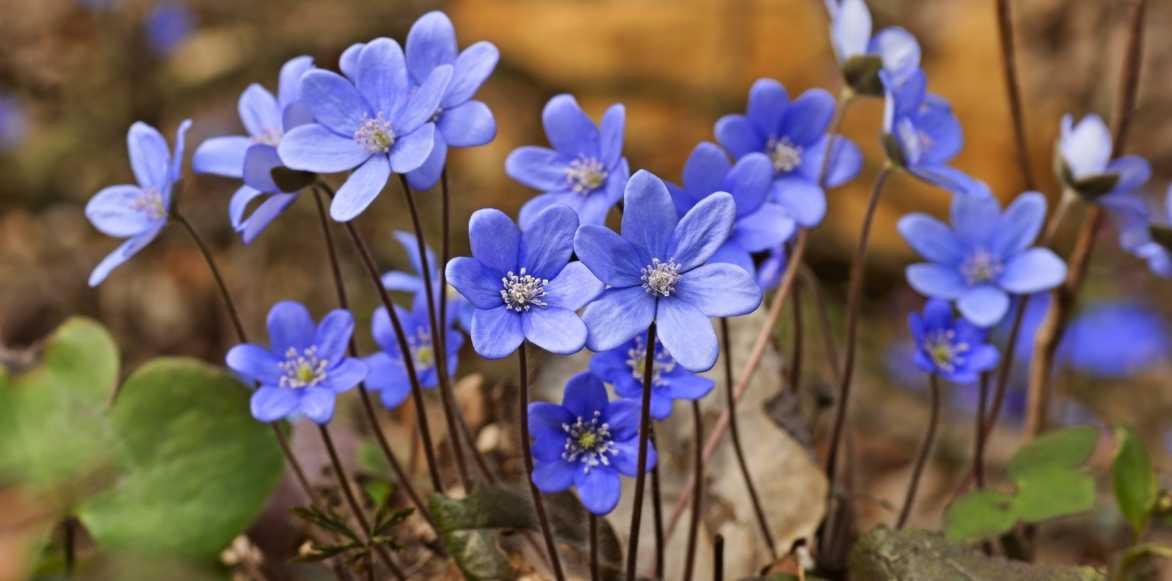
Hepatica nobilis
Description and botany
Botanical data
- Latin name Hepatica
- Family Ranunculaceae
- Common name Liver leaf, Hepatic
- Flowering March to April
- Height 0.15 cm
- Exposure Partial shade, shade
- Soil type Cool, well-drained
- Hardiness -15 °C and beyond
Liverleaf, Hepatica in Latin, is a small perennial woodland plant closely related to wood anemones (Anemone nemorosa), belonging to the Ranunculaceae family, like buttercups. It can be found throughout most of Europe, as well as in Siberia and northern America. The genus comprises about ten perennial species, with the most widespread representative being Hepatica nobilis, also known as liverleaf or noble hepatic. Very hardy, this species grows spontaneously in our regions. It is found in deciduous woodlands, particularly mountainous areas (up to 2200m altitude) in the East and South of France, in the Alps, the Pyrenees, and also in Corsica. Hepatica nobilis has given rise to numerous cultivars. Hepatica nobilis var. Japonica is a selection from Japan that has produced the varieties in the ‘Forest’ series.
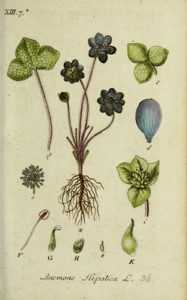
Anemone hepatica, botanical plate (1862)
From a short, fibrous stump, this herbaceous perennial slowly forms a carpet of leaves 15 cm high and 15 to 20 cm in diameter. It develops in rosettes of mostly evergreen leaves that renew in spring after flowering. These basal leaves, 3 to 6 cm long, are thick, leathery, and borne on long petioles. They feature a lamina divided into 3 rounded or pointed lobes fringed with very fine hairs. They are dark green and matte on top, sometimes marbled with white, and coloured wine-red on the underside, which has earned the plant its nickname “Liverleaf” due to this hue and their trilobed shape, reminiscent of a liver.
Flowering occurs in March-April, more or less early depending on the climate, before the new leaves appear, heralding the return of fine weather. Each solitary flower is borne on a fluffy stem just above the foliage. They measure 2 to 4 cm in diameter and consist of 6 to 9 oval sepals radiating around a heart of white or pink stamens that are clearly visible, gathered in a diadem. The colour of these simple corollas, very rarely semi-double, ranges from pure white to purplish-blue in Hepatica nobilis ‘Purple Forest’, to royal blue in the species type, and to magenta-pink in Hepatica nobilis ‘Red Forest’. Their colour can vary depending on the nature of the soil.
They are encased in an involucre formed of three bracts.
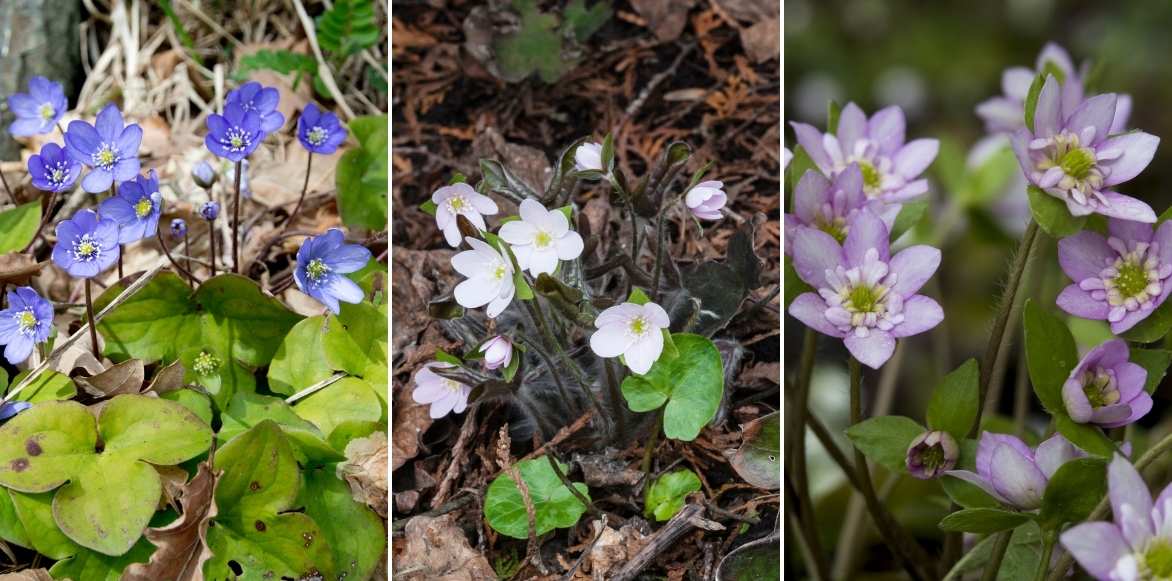
Flowers and foliage of liverleaves. On the right, Hepatica nobilis var. Japonica
Once pollinated, the flowers produce small seeds that are collected and dispersed in the garden by ants (myrmecochorous dispersion), leading to spontaneous sowing.
In the Middle Ages, Hepatica nobilis was renowned as a medicinal plant for treating the liver. Today, it is considered a toxic plant in large doses. In the language of flowers, the liverleaf signifies trust.
Read also
What to plant under a tree?Main species and varieties
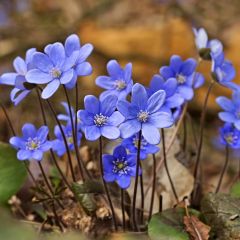
Hepatica nobilis
- Flowering time March, April
- Height at maturity 15 cm
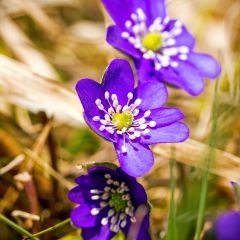
Hepatica nobilis Purple Forest
- Flowering time April, May
- Height at maturity 15 cm
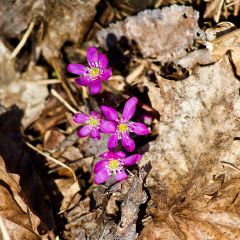
Hepatica nobilis Red Forest
- Flowering time April, May
- Height at maturity 15 cm
Discover other Hepatica
View all →Available in 1 sizes
Available in 1 sizes
Available in 1 sizes
Available in 1 sizes
Available in 1 sizes
Available in 1 sizes
Available in 1 sizes
Planting
Where to plant?
Hepatica is a very robust plant, hardy down to -30°C for Hepatica nobilis. The varieties from the ‘Forest’ series are less hardy than our European hepatica, yet they still show commendable cold resistance, down to -15°C.
It acclimatises everywhere except perhaps in a Mediterranean climate, which is too dry and hot in summer.
This small perennial thrives in partial shade and woodland; it is never happier than under the cover of deciduous trees and bushes that provide the necessary shade in summer. In its native habitat, this montane plant carpets limestone rocks. While it prefers soils with a tendency towards limestone, it will also flourish in soil enriched with leaf mould.
It will form lovely loose cushions in cool, even somewhat dry soil in summer, very rich in humus and always well-drained, as it is sensitive to excess water.
Hepatica develops slowly, so once well-rooted, it does not like to be moved: choose its location carefully.
If conditions are suitable, it will self-seed wherever it pleases, sometimes quite far from its original location.
It will brighten up woodlands and all slightly shaded areas of the garden, cool rockeries, and borders along paths or flower beds. Planting it in an elevated position will allow you to appreciate its lovely early flowering.
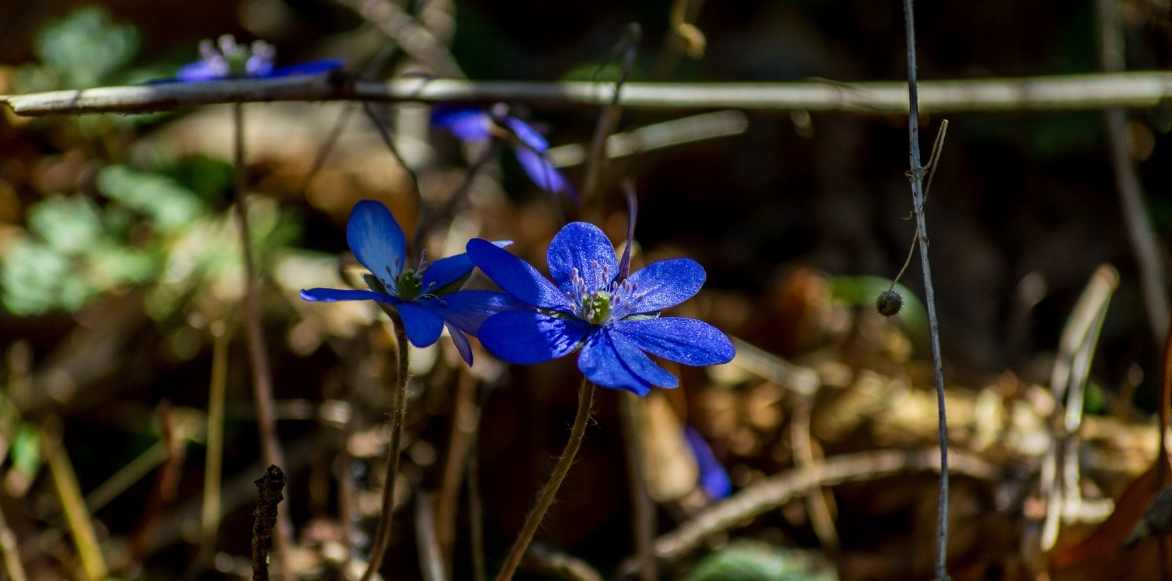 Hepatica thrives in woodland situations, in the shade of trees
Hepatica thrives in woodland situations, in the shade of trees
When to plant?
Plant Hepatica preferably in autumn from September to November, avoiding frost periods, so it can establish well before winter and benefit from autumn rains. Spring planting is also possible, provided you monitor watering, as it will need regular water supplies to encourage rooting, especially if the months following planting are dry.
How to plant?
In the ground
Choose a location in partial shade. Plan for at least 6 pots to create a lovely group effect. Plant 25 cm apart in all directions. Your soil must be well-drained, as Hepatica does not appreciate stagnant moisture at the roots.
-
- Dig a hole 2 to 3 times wider than the root ball
-
- Place the plant in the centre of the hole, with the collar level with the soil
-
- Cover with a mixture of soil and leaf mould, especially if the soil is heavy, to lighten it
-
- Firm down
-
- Water generously and then regularly to encourage establishment
-
- Mulch with leaf mould or well-rotted compost to keep the soil cool
In a pot
Growing Hepatica in pots is possible. Preferably use a terracotta container with drainage holes.
-
- Drain the bottom of the pot with gravel or clay balls
-
- Add equal parts garden soil (or potting compost), clay balls, and leaf mould
-
- Position the root ball and fill in with the remaining substrate
-
- Gently firm down, water, and then place the pot in a sheltered spot away from the harsh rays of the sun
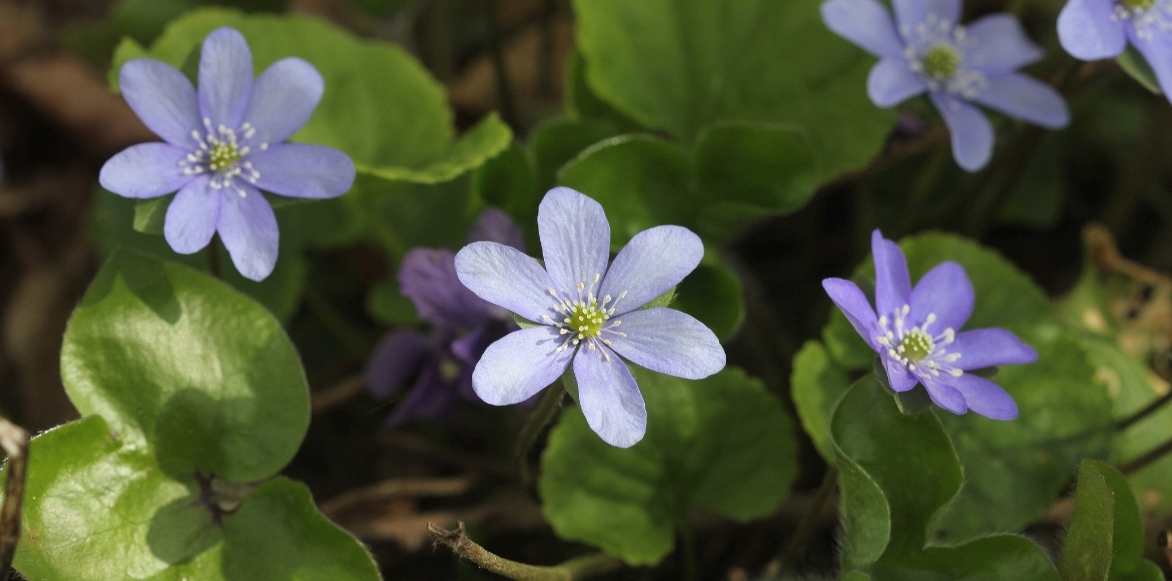 Hepatica nobilis
Hepatica nobilis
Growing and care
Once well established in a suitable location, Hepatica is a nearly maintenance-free plant.
Ensure to water it regularly during the first year of growth, then 1 to 2 times a week during hot weather. It enjoys soil that remains cool in summer: spread a layer of mulch (a good leaf compost, for example) at its base to prevent the soil from drying out.
Each spring, add some compost at the base.
Divide every three to five years in autumn to rejuvenate the clumps.
In pots, keep the substrate moist, especially in summer or if it doesn’t rain; it should not dry out between waterings. During the growth period, starting in March, you can fertilise with a liquid fertiliser suitable for flowering plants. Repot every three years into a larger pot.
In spring, follow our advice to protect the new leaves from slugs and snails.
Multiplication
Dividing clumps in autumn, in September-October, is a simple method to multiply liverworts. You can attempt sowing under a cold frame in autumn, but you will likely obtain plants that are not identical to the parent plant. Transplant the seedlings at the beginning of autumn into individual pots. The installation will take place the following spring.
- Using a fork, lift a section of mature stump
- Divide it into several pieces
- Immediately replant these parts in the ground or in pots and water generously
Pairing ideas
With their simple, colourful, and early flowering and their evergreen foliage, hepatica awaken the shaded and wooded corners of the garden. They carpet the base of trees and bushes, brightening the front of borders, rockeries, or even pots and planters.
As they thrive in semi-shaded conditions and cool soil, don’t hesitate to plant them at the edge of woodlands, alongside shade-loving perennials such as ferns, hardy geraniums or bulbous plants like bluebells and wood anemones. Also consider groundcover perennials for shade such as heucheras and brunnera, excellent companions. As they grow slowly, be careful not to expose them to competition from overly invasive neighbouring plants.
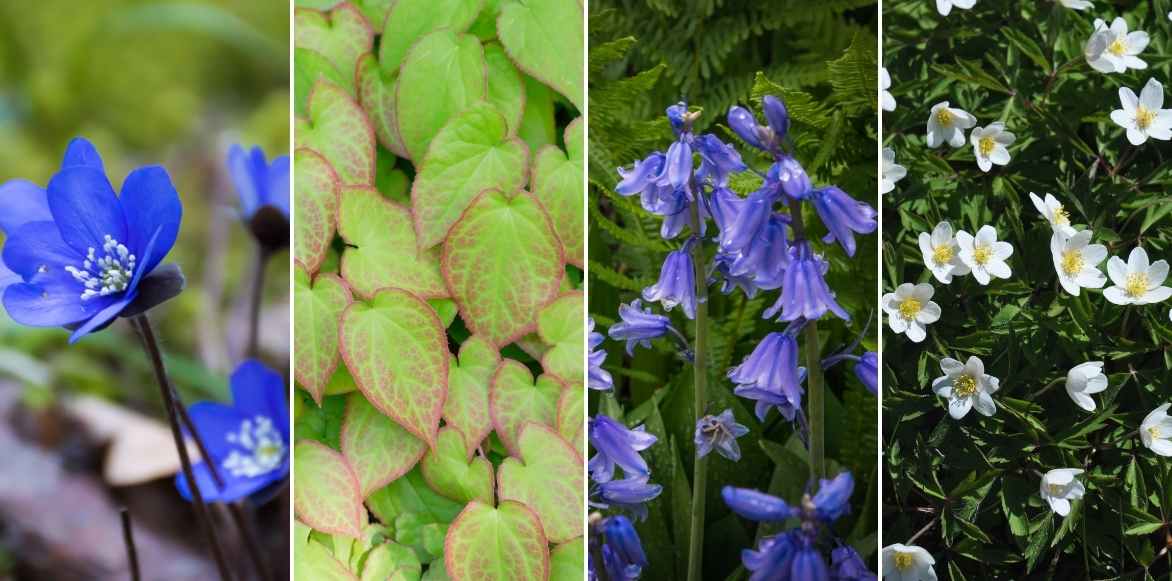
Hepatica, epimediums, bluebell and ferns, and wood anemones
In a cool rockery, they accompany epimediums and saxifrages.
In borders, they will edge the base of deciduous shrubs such as deutzias and mock oranges which will provide them with welcome coolness during the summer.
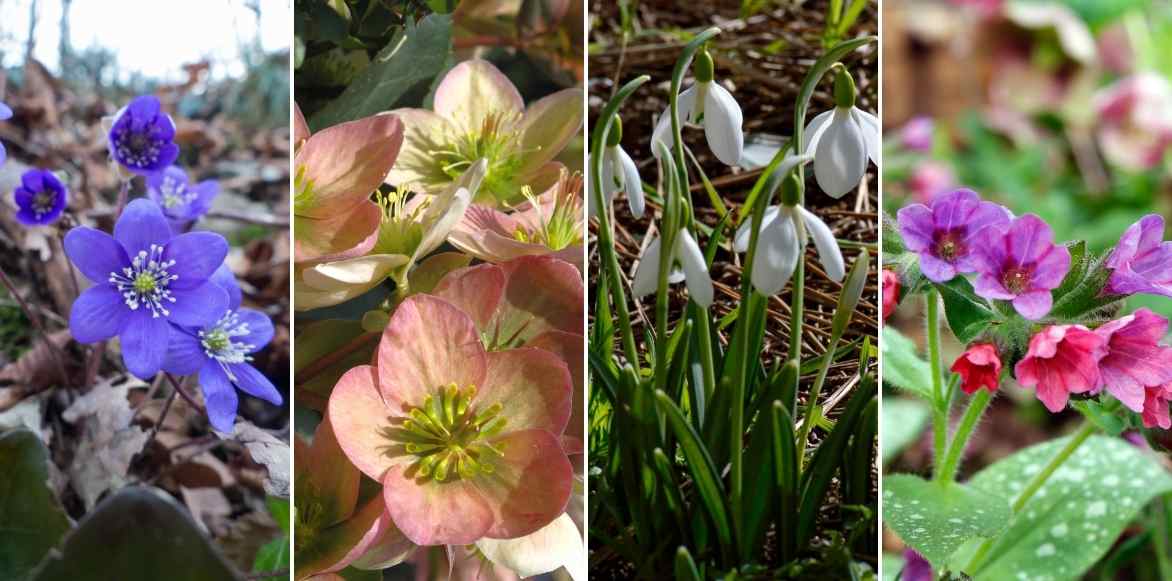
Hepatica, hellebores, snowdrops and pulmonarias
They are perfect for completing fresh and delicate scenes heralding the arrival of spring with early spring bulbs such as crocuses, snowdrops, and winter-flowering perennials like hellebores, winter aconites, and pulmonarias.
Useful resources
- Do you have a woodland to flower? Get inspired by our advice sheets “What to plant under my trees?” and our solutions and suitable plants
- What are the best plants to grow in woodland
- Subscribe!
- Contents


































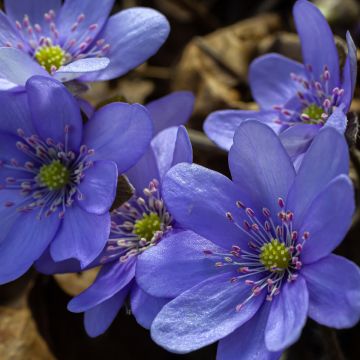
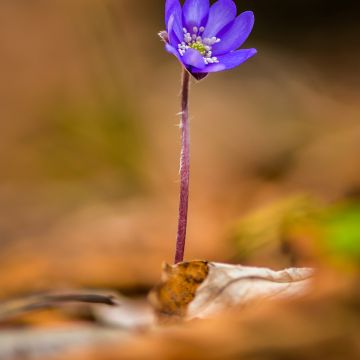
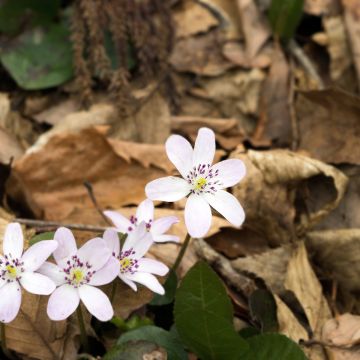
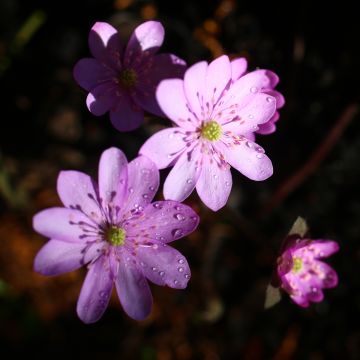
Comments